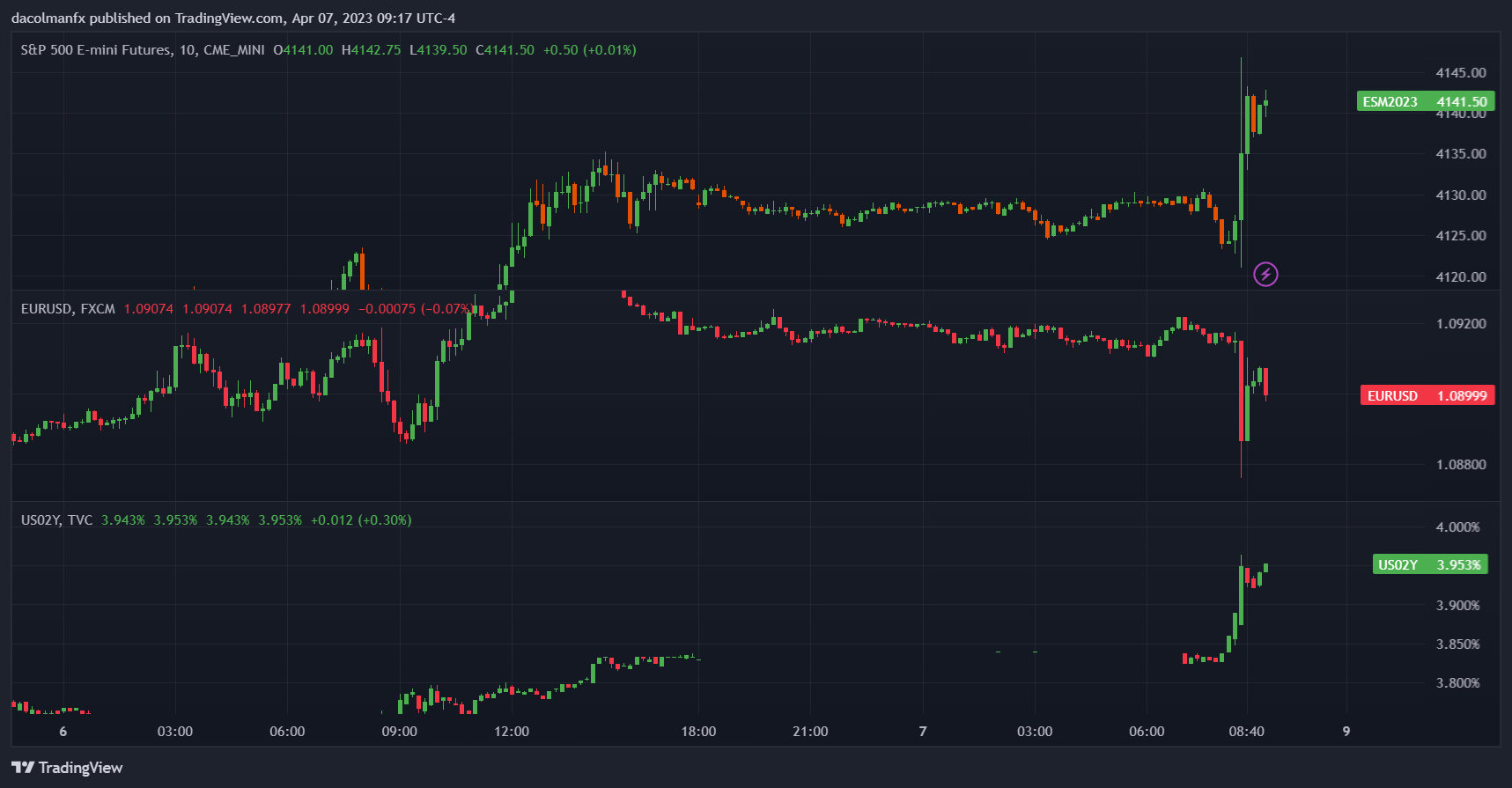MARCH LABOR MARKET REPORT:U.S. employers add 236,000 workers in March versus expectations of a gain of 239,000 jobsMeanwhile, the unemployment rate ed
MARCH LABOR MARKET REPORT:
- U.S. employers add 236,000 workers in March versus expectations of a gain of 239,000 jobs
- Meanwhile, the unemployment rate edges lower to 3.5%, one-tenth of a percent below consensus estimates
- For its part, average hourly earnings clock in at 0.2% m-o-m and 4.2% y-o-y
Most Read: US Dollar Q2 Technical Forecast – Sellers Take Hold of Steering Wheel for Now
Updated at 9:20 am ET
MARKET REACTION
Immediately after the NFP report crossed the wires, S&P 500 futures wiped out losses and moved into positive territory despite the jump in Treasury yields. Meanwhile, EUR/USD took a turn to the downside, but the knee-jerk reaction quickly faded. With cash markets closed today, these moves may not be an accurate reflection of sentiment, so traders will have to wait until Monday to get a better idea of how key assets will trend going forward following March labor market data.
S&P 500 FUTURES, EUR/USD & TREASURY YIELDS CHART

Source: TradingView
Original Post at 8:55 am ET
U.S. employers continued to add to their ranks at a healthy pace at the end of the first quarter despite the advanced stage of the economic cycle, but hiring decelerated moderately compared to earlier in the year, a sign that companies are becoming a tad more cautious about their plans to expand headcount.
According to the Bureau of Labor Statistics, the U.S. economy generated 236,000 jobs in March, versus 239,000 expected, following an upwardly revised gain of 326,000 payrolls in February. Meanwhile, the unemployment rate ticked down to 3.5%, one-tenth of a percent below consensus estimates, even as the labor force participation level climbed to 62.6% from 62.5%.
UNEMPLOYMENT RATE AND NONFARM PAYROLLS

Source: BLS
Elsewhere in the employment survey, average hourly earnings, a powerful inflation gauge closely tracked by the U.S. central bank, increased by 0.3% on a seasonally adjusted basis, bringing the annual rate to 4.2% from 4.6% previously – the lowest since June 2021. Analysts polled by Bloomberg News were looking for wages to rise 0.3% monthly and 4.3% in the last 12 months.
LABOR MARKET DATA AT A GLANCE

Source: DailyFX Economic Calendar
Although slower pay growth may frustrate Americans, it is a welcomed development for the Fed insofar as it signals that labor market tightness is easing – a key step in the process of reducing inflationary pressures and restoring price stability. If sustained, weaker wage growth could pave the way for a less restrictive monetary policy stance over a medium-term horizon.
MARKET IMPACT
Due to the Good Friday holiday, financial markets are closed today in the United States and Europe. Because of that, the reaction in some assets still trading may be being exaggerated by the lack of liquidity.
In any case, the slowdown in hiring to a pace more consistent with restoring the balance between worker supply and demand, along with moderating wage pressures, may convince the Fed that interest rates are close to a sufficiently restrictive level, prompting policymakers to err on the side of caution in terms of future actions. This means a pause could be in the cards for the May FOMC meeting, though it is still not a done deal.
All in all, the direction of travel is likely to be lower for the U.S. dollar going forward if the economy continues to cool. However, if sentiment deteriorates materially, and volatility explodes higher, the greenback could be well-positioned to command strength against riskier peers by virtue of its safe-haven qualities.
Written by Diego Colman, Contributing Strategist
element inside the
element. This is probably not what you meant to do!Load your application’s JavaScript bundle inside the element instead.
www.dailyfx.com